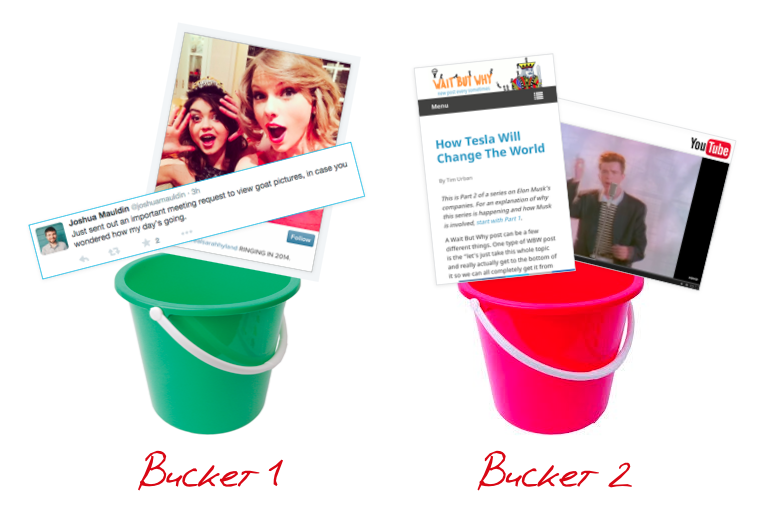Sharing media content is inherently different than sharing selfies.
It’s tempting to group all content into one big bucket. Text messages, status updates, photos, articles, videos — all variations of the same thing: content. But to me there are actually two distinct types of content, and they must be handled differently.

Bucket 1:
- small chunks of text (ex: text message, tweet)
- photos ( ex: selfie on Snapchat, a brand’s post on Instagram)
- super short videos (ex: Vine)
Bucket 2:
- long form text (ex: articles, blogs)
- videos (ex: any video more than a few seconds long)
Notice that my division is not between personal and professional content, which I believe is a common category error. These are two different sets of media types, not two different sets of sources/creators. As it turns out, Bucket 2 content is more typically created by professionals and Bucket 1 content is more typically created by amateurs, but obviously there are a million examples of the opposite being true, and it’s changing quickly.
Rather, the dividing line between the two buckets is how fast the content can be consumed. If it can be consumed in let’s say ≤ 10 sec., throw it in Bucket 1. If > 10 sec., then it goes in Bucket 2.
This is significant, because with Bucket 1 content, receiving the message is synonymous with consuming it. If I send you a photo, you both receive it and consume it at once.
However if I send you an article, you receive it, but it is not instantly consumed. Often the actual consumption is deferred because you don’t have the proper time or attention to give at the moment of receipt.
Deferred communication is fundamentally different than realtime or normal asynchronous communication, because there are three steps: send, receive, consume. Consuming the content can take a long time i.e. reading an article or watching a video. Whereas in the other models, receive and consume are a single step; the consumption is almost instantaneous.
When I look at the communication tech landscape, I see that most solutions treat all content the same. We use single aggregated services for both buckets of content (Gmail, Facebook, Twitter, WhatsApp, etc.).
But deferred communication is quite different, and as more tools crop up that acknowledge those differences, I believe there will be a significant shift in how we share content.





